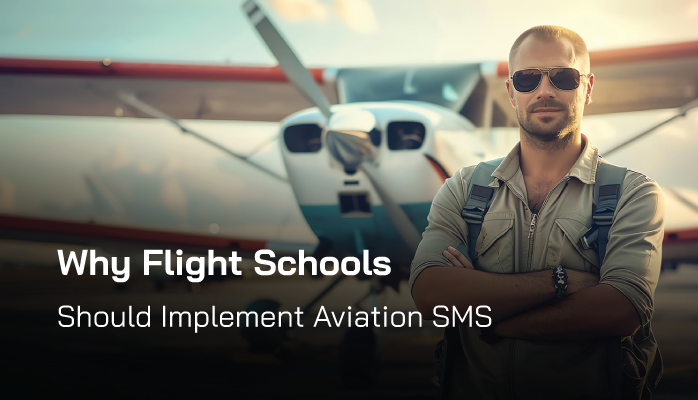Benefits of Aviation SMS for Flight Schools

Flight schools operate with many risky hazards every day.
Students are inexperienced, usually younger, and are new to technology and the hazards of flying.
Moreover, the pressure that students undergoing flight training feel to perform well naturally makes them less prepared to identify hazards early on.
Of course, while flight schools need to prepare highly successful pilots, maintenance workers, air traffic controllers, etc., the FAA’s new compliance policy that airlines have a safety management system in place is a testament to the fact that safety performance is an integral part of overall performance. To understand flight safety in airlines, aircraft, and airports, aviation students need:
- Hands on experience and practice with aviation safety management systems (SMS);
- To understand what aviation SMS are; and
- To know how their role in aviation is integrated into safety processes.
Implementing formal, structured SMS in flight schools is a great opportunity to close the gap between theoretical knowledge and real-world practices. Students who have been prepared with practical SMS experience in school will undoubtedly acclimate faster to the procedures of their chosen organization.
Of course, flight schools are generally simple operations, which means that their SMS implementations can necessarily be extremely manageable and straightforward as well. Here are several basic reasons why flight schools should have aviation SMS implementations.
Related Articles on Aviation SMS Implementations at Flight Schools
- 3 Ways How Flight Schools Can Use Aviation SMS
- Safety Promotion From Flight School Aviation SMS
- 3 Inexpensive Ways to Promote Safety at Flight Schools & Other Aviation SMS Programs
Aviation SMS Tools Provide Real-World Training
The core driver of aviation SMS performance is hazard identification activity and subsequent data acquisition using safety reporting forms. The data provided by reported safety issues have pushed the boundaries of aviation safety to even higher levels of effectiveness. The ability to easily and confidentially report safety hazards also involves being able to accurately identify hazards and the precursors of risks.
Using safety reporting tools in flight schools has three primary advantages when it comes to real-world application:
- Students will get in the habit of hazard identification;
- They will receive practice reporting safety issues; and
- Hazard identification and safety reporting procedures will be familiar wherever they choose to work.
In short, flight schools that naturally integrate SMS tools into their courses will provide real-world training for proactive risk management. Considering a large majority of students will be mostly interacting with SMS for identifying, reporting, and navigating things like policies and procedures, simple SMS processes like safety reporting are a simple, subtle, but effective way to prepare aviation students for real-world application of their learning.
Aviation Safety Management System Is Compliance

Aviation SMS will soon become a mandatory regulatory requirement for all service providers. In short, SMS will become a functional component at all levels of aviation, and learning SMS-oriented responsibilities will be as necessary as other students' regular performance duties.
As such, it would behoove flight schools to optimize their training courses by creating an environment that most closely matches a real-world scenario. Students would have the opportunity to become acquainted with the processes, goals, and roles that are relevant to their position in the safe, controlled environment of their flight school.
Integrate Safety Into Performance Early On
By the time students graduate from their flight school or training program, they will have logged many hours of training, hardening their procedures and behaviors to optimize their performance on important duties.
A mindset of safety needs to be an integral part of their education. This might mean taking training a bit slower to account for:
- Best safety practices; and
- Common hazards and risks to be identified.
However, integrating safety performance early on will in-grain proper safety practices and save students from a steeper learning curve when entering their real-world environment. The experience of leaving the confines of training and starting work in the aviation industry will be stressful enough on its own. Having to relearn behavior for proper safety practices will hinder performance in students' new organizations.
Related Aviation SMS Training Articles
- Understanding Role of Hazard Identification Training and Safety Reporting Forms in Aviation SMS
- 3 Top Topics for Aviation SMS Training to Focus On
- Best Ways to Automate Aviation Safety Training for Initial/Recurrent Requirements (Free Resources)
Final Thought: Choosing Which SMS Tools to Have
As said, general aviation flight schools are generally non-complex operations, and flight schools that wish to integrate aviation SMS concepts into their regular training curriculum will need to choose the necessary types of SMS tools. In general, the types of SMS tools that integrate seamlessly into flight schools are:
- Safety reporting tools;
- Flight Risk Assessment Tools (FRAT);
- Weight and Balance tool;
- Gap Analysis tools; and
- SMS implementation tools.
These basic SMS components can provide flight school students with an underlying foundation of the goals and aims of aviation SMS, and create fluency by using important, industry-standard safety tools.
SMS Pro's "Flight School Hazard Reporting & Risk Management Software" is based on the user-friendly, easy-to-use Hazard Reporting Solution's core modules. Here are some demo videos you may be interested in if you wish to acquire some low-cost, commercially available SMS database tools to add structure to your SMS implementation.
Last updated in April 2025.





